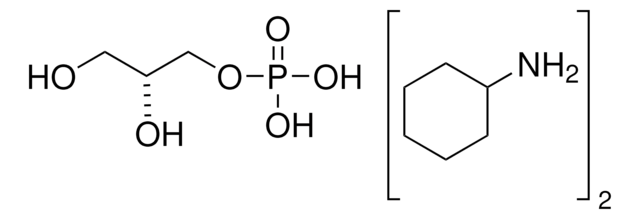5.30655
Mitochondrial GPDH Inhibitor, iGP-1
Synonim(y):
Mitochondrial GPDH Inhibitor, iGP-1, N-(4-(1H-Benzoimidazol-2-yl)-phenyl)-succinamic acid, Mitochondrial sn-Glycerol-3-Phosphate Dehydrogenase Inhibitor, mGPDH Inhibitor, inhibitor of m GPDH 1, iGP1, N-(4-(1H-Benzoimidazol-2-yl)-phenyl)-succinamic acid, Mitochondrial sn-Glycerol-3-Phosphate Dehydrogenase Inhibitor, mGPDH Inhibitor, inhibitor of mGPDH 1, iGP1
About This Item
Polecane produkty
Próba
≥98% (HPLC)
Poziom jakości
Postać
solid
siła działania
6.3 μM IC50
producent / nazwa handlowa
Calbiochem®
warunki przechowywania
OK to freeze
protect from light
kolor
beige
rozpuszczalność
DMSO: 50 mg/mL
temp. przechowywania
2-8°C
Opis ogólny
Działania biochem./fizjol.
mGPDH
Opakowanie
Ostrzeżenie
Rekonstytucja
Inne uwagi
Informacje prawne
Kod klasy składowania
11 - Combustible Solids
Klasa zagrożenia wodnego (WGK)
WGK 3
Temperatura zapłonu (°F)
Not applicable
Temperatura zapłonu (°C)
Not applicable
Certyfikaty analizy (CoA)
Poszukaj Certyfikaty analizy (CoA), wpisując numer partii/serii produktów. Numery serii i partii można znaleźć na etykiecie produktu po słowach „seria” lub „partia”.
Masz już ten produkt?
Dokumenty związane z niedawno zakupionymi produktami zostały zamieszczone w Bibliotece dokumentów.
Klienci oglądali również te produkty
Nasz zespół naukowców ma doświadczenie we wszystkich obszarach badań, w tym w naukach przyrodniczych, materiałoznawstwie, syntezie chemicznej, chromatografii, analityce i wielu innych dziedzinach.
Skontaktuj się z zespołem ds. pomocy technicznej







